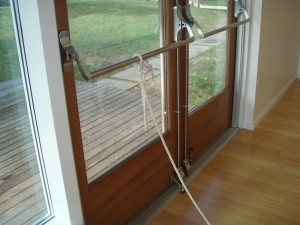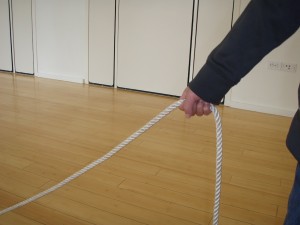It amazes me that almost every girl in my second grade class (probably 20) waited in line to jump rope during recess. On a good day we may have had three turns during that precious thirty minute break. There was no adult telling us to do this. It’s just what we did.
We didn’t do the fancy inner city trick jumping. We jumped to “Bluebells, cockle shells, eevie, ivy, over; I like coffee, I like tea; I like the boys, and the boys like me.” Can’t blame peer pressure. There was just something about rope jumping at that time of life that felt right.
Jumping rope is a tried and true activity that has lasted through many generations. Why? Because jumping rope integrates many parts of the body and helps solidify maturing motor skills.
Benefits:
- It requires strength in the legs in order to be able to jump off the ground (strength and endurance).
- It requires the legs to move separately from the body (isolated movement).
- It requires the legs to move together (bilateral motor coordination).
- It requires the ability to sustain a specific movement repeatedly.
- It requires the ability to develop a rhythm to the movement.
- All of this leads to a smooth well coordinated motor sequence.
Because jumping rope is complicated, a child usually doesn’t master this activity until first grade. Strong Kindergarten aged children can learn as well.
For younger children, there are many games that will build motor confidence and the components necessary for eventual rope jumping.
The video below demonstrates how it works.
Directions:
1. “Boots” represents a very young child who is just learning to jump. Use a rope, placed on the floor and ask the child to jump over the rope. The goal is to jump with both feet together. The ultimate goal is to be able to jump over the rope several times.
2. “Socks” represents a slightly older child, who is able to jump over the rope but now tries to link the movement for a longer period of time. The red disk pictured is there to help the child stay in one approximate location. Otherwise, the tendency is to keep moving forward, which does not work when jumping rope.
3. An older child is featured next. A series of games can be played to ready the child for real rope jumping. -jump over the rope while standing still…raising the rope slightly higher each time -jump over the rope when it is swayed back and forth but not over the child’s head
4. Full rope jumping soon follows!
If there is only one adult, tie a rope to a door knob when inside.
Notice how this boy holds the rope with his thumb wrapped around the rope.
The child swinging the rope exercises the Arm and Hand muscles and also develops a sense of rhythm as well!
Special Considerations:
Why is motor sequencing important?
- Almost all activities that are executed in a coordinated way require the ability to carry out a motor sequence.
- It is a culminating and key ingredient to good motor planning. But it doesn’t end with motor skills.
- Sequencing is critical for many aspects of learning.
- Language (in essence, talking!) requires quite a bit of sequencing.
- Learning to read requires the ability to sequence.
- Learning to write-ditto!
So each time kids pull out the jump rope, they might as well be reaching for their spelling books and reading anthologies. Jumping rope-so much more fun than copying those spelling lists.
Each time a child engages in motor sequencing activities, they are laying down neurological pathways that lead to sequencing or linking of thoughts and actions into purposefull activities. The more efficient the pathways, the easier it is to learn!
It can be done inside or out. Turn off those electronic devices and tie up a rope to a door knob.

